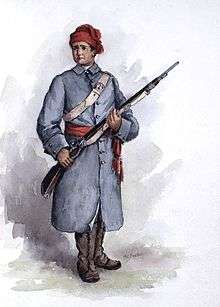Canadian Militia

The Canadian Militia is a traditional title given to volunteer forces raised from local communities for the defence of Canada. Militia forces played an instrumental role both under the French regime (prior to 1763) and under British rule (after 1763). It is also the title given to the land forces of Canada from Confederation in 1867 to 1940 when it was renamed the Canadian Army.
Service in New France
Use of militias date back to New France. In 1669, King Louis XIV, concerned about the colony's inability to defend itself adequately against raids, ordered the creation of a compulsory militia that would include every fit male between 16 and 60 years of age. They were organized into companies, usually one per church parish, and structured in the same way as a regular French infantry company. The men were noted as excellent shots (most came with their own rifle, powder and bullets), and in better physical condition than regulars, because of their tough life, farming, fishing and hunting. Volunteer militiamen were used to support the regulars and their First Nation allies on lengthy raids, where they absorbed the skirmishing tactics of the latter. However, little time was spent on conventional European drill.[1]
Service in the Canadas and post-Confederation

Following the British conquest of New France, local militia units continued to be raised, and support British soldiers stationed in the Canadas. However, as the British began to withdraw soldiers from British North America, the Legislative Assembly of the Province of Canada passed the Militia Act of 1855, creating the Active Militia.[2] The Active Militia, later referred to as the Permanent Active Militia (PAM), was created as a regular armed unit, although it continued to use the label militia. After PAM's formation, the remaining sedentary militia regiments were collectively referred to as the Non-Permanent Active Militia (NPAM).[3] Prior to Confederation, the colonies that made up The Maritimes maintained their own militias independent of the Canadian Militia.[4]
In 1940, PAM was renamed Canadian Army (Active) and the NPAM as Canadian Army (Reserve). The two units were renamed following World War II as Canadian Army Active Force, Canadian Army (Regular) and Canadian Army Reserve Force respectively.
In the 1950s, the reserve force again adopted the title "Militia" and that title has remained an unofficial designation for part-time soldiers of the land forces of the Canadian Forces.
In 1968, the Militia was re-organized for the last time under Mobile Command (and Mobile Command (Reserves)) under the unified Canadian Armed Forces.
Today, the term is no longer used to describe any recognised military force in Canada. Only the unofficial Militia of Upper Canada carry on the use of the word "militia".
See also
References
- ↑ Chartrand, René Canadian Military Heritage Vol1 1000-1754 pp 73-100
- ↑ "The 1855 Volunteers". Canadian Military Heritage, vol. 2. Government of Canada. 1 May 2017. Retrieved 15 December 2017.
- ↑ "The Defence of Canada by Canadians". Canadian Military Heritage, vol. 3. Government of Canada. 1 May 2017. Retrieved 15 December 2017.
- ↑ "In the Maritimes". Canadian Military Heritage, vol. 2. Government of Canada. 1 May 2017. Retrieved 16 January 2018.
External links
- canadiansoldiers.com
- Corinne McDonald (29 November 1999). "THE CANADIAN ARMED FORCES: THE ROLE OF THE RESERVES". Political and Social Affairs Division. Retrieved 17 May 2013.